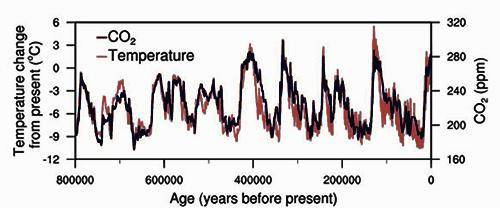
Advanced Placement (AP), 21.05.2021 01:00 erickamurillo9929
Glaciers typically grow during Ice Age cycles and retreat during interglacial periods. Over the last 800,000 years, there have been eight Ice Age cycles. During the most recent Ice Age, glaciers covered about 32 percent of the land and 30 percent of the ocean. We are currently in an interglacial period, and glaciers cover about 10 percent of the land area, mostly in the polar regions. This is part of the normal climate variation cycle.
The graph below shows the global carbon dioxide levels and temperatures over the last 800,000 years:
Graph shows temperature change in degrees Celsius and change in carbon dioxide in the atmosphere in parts per million over last 800,000 years. At approximately 750,000, 650,000, and 50,000 years ago, the temperature average dropped to negative 10 degrees below the average and carbon dioxide dropped to approximately 150 part per million. At approximately 550,000, 450,000, 350,000, 250,000 and 150,000 years ago, the temperature average dropped to negative 9 degrees below the average and carbon dioxide dropped to approximately 175 part per million. At approximately 800,000, 700,00, 600,000, and 500,000 years ago, the temperature average increased to 2 above the average and carbon dioxide dropped to approximately 150 part per million.
© 2020 NOAA
Figure 1: Temperature change (light blue) and carbon dioxide change (dark blue) measured from the EPICA Dome C ice core in Antarctica.
Refer to the graph in figure 1 to answer the following questions:
Identify the approximate amount of time between ice ages on the graph.
Explain the relationship between carbon dioxide and temperature in the graph.
Describe two human activities that release carbon dioxide into the atmosphere.
Within the past 200 years, human activity has increased the amount of carbon dioxide in the atmosphere by 40 percent, warming the atmosphere and causing the glaciers to retreat much more rapidly than in a normal cycle.
Describe two impacts climate change will have on sea ice ecosystems.
Propose a solution to reduce the impact of melting glaciers on Earth's biodiversity.
Justify how this solution would protect marine or land species from extinction.


Answers: 2
Another question on Advanced Placement (AP)

Advanced Placement (AP), 22.06.2019 03:00
Due to a freak snowstorm that lasted an entire week, students had a packet of 24 math worksheets to finish. by friday, peter had done 56 of the worksheets, tony had completed 11/12 and natasha had 21/24 finished. who had the most worksheets finished? the least? justify your answer by explaining how you were able to compare the fractions. there were 24 books on the summer reading list. susan has read 6 5 of the books on the list. tom has read 12 11 of the books on the list. vicky has read 24 21 of the books on the list. which list correctly compares the fractions of books on the summer reading list that susan, tom, and vicky have read?
Answers: 3

Advanced Placement (AP), 22.06.2019 22:20
Astudent who takes a multiple-choice test by reading the stem of each item, generating the correct response before looking at the choices, and then chooses the response closes to the answer is using a.a heuristic b.an algorithm c.vicarious problem-solving d.means-end analysis
Answers: 1

Advanced Placement (AP), 25.06.2019 05:30
The closer the genetic link between two individuals, the greater the correspondence
Answers: 2

Advanced Placement (AP), 25.06.2019 16:00
Evidence suggests that the ancient romans had a very formal medical system. it included which of the following? click all that apply. medical schools universities physician apprenticeships nursing homes hospital facilities
Answers: 1
You know the right answer?
Glaciers typically grow during Ice Age cycles and retreat during interglacial periods. Over the last...
Questions



Mathematics, 19.03.2021 14:00

English, 19.03.2021 14:00

Computers and Technology, 19.03.2021 14:00

English, 19.03.2021 14:00

History, 19.03.2021 14:00


English, 19.03.2021 14:00

Mathematics, 19.03.2021 14:00



Chemistry, 19.03.2021 14:00

Business, 19.03.2021 14:00



Mathematics, 19.03.2021 14:00



History, 19.03.2021 14:00



